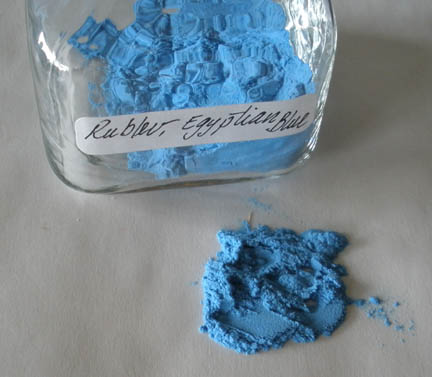Though often lavishly used in decorative arts in Egypt for thousands of years, there is no evidence that lapis lazuli was used as a pigment. The ancient Egyptians invented a different and just as beautiful blue called Egyptian Blue frit, shown above. This pigment consisted of a crystalline compound of silica, copper, and lime. It is thought the development of this color was the outcome of a glaze. If it is heated to a higher temperature it becomes a glaze called faience. By heating to a lower temperature, about 900 to 1000 degrees, the consistency is crumbled particles called frit, which can then be ground into a pigment. It was a manufactured product made with quartz, calcium carbonate, malachite, and soda ash.
This color is one that is completely new to my pigment palette, so I am excited about experimenting with it. Has anyone tried this color before? What applications have you used? Did you grind it yourself?
Source: Ancient Egyptian Materials, A. Lucas, O.B.E., F.I.C.


I’ve never tried it but I was interested in fining out is use in oil paint from a source separate from Rublev. My concern would be with toxicity and archival rating in oil. Now, I know it has a copper component. Copper based pigments, from what I understand are quite toxic in powder form. I know you know how to work with toxic pigments and take proper precautions when grinding. So, that’s not an issue. Here’s a link to a site and what it has to say about the use of Egyptian blue – really only discusses its main value as a glazing pigment.
http://www.artiscreation.com/blue.html
Although egyptian blue is a copper silicate pigment its actual toxicity is quite low. It is lightfast and compatible with all other known pigments. There are many examples of this pigment in Greek and Roman murals that have survived out of doors for thousands of years.
Thank you so much, Mr. O’Hanlon, for clarifying the toxicity issue for the previous reader. Hopefully this will ease the anxiety of the use of beautiful Egyptian Blue pigment. Margret Short